Share
Or copy this URL:
https://www.metalroofing.com/news/how-much-does-metal-roof-cost-compared-shingles/
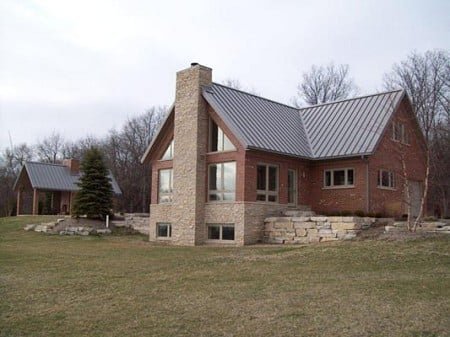
Posted by McElroy Metal
NOTE: This content was published in April 2022 to reflect current material prices and inflation. In these uncertain times, metal roofing continues to be an excellent long-term investment.
When faced with roof replacement, many homeowners have settled for the cheapest, most popular product - asphalt shingles. But over the past several years, a funny thing has happened. Homeowners, tired of the constant churn of shingle replacement, are searching for better roofing options.
Perhaps that’s why residential metal roofing continues to gain in popularity. With increasing frequency, homeowners consider the possibilities of a metal roof on possibly their most significant investment, their home. Based on recent data, metal roofing now holds 12% of the remodel market share and 8% of the spending for new residential construction. Think about those statistics for a moment. That means 12% of the homes needing a roof replacement no longer replace their shingle roof with another roof. Why?
Because, in many cases, they’re simply tired of the never-ending cycle of budgeting for and paying off a roof on their home. In the wise words of Albert Einstein, they’re just over the insanity of it all.
Consequently, many homeowners are researching the possibility of metal roofing for their homes, and of course, product cost is a necessary component of any research effort. With metal roofing lasting three times as long, most homeowners expect the product to cost more; however, the question is, how much more?
For a better understanding, let’s look at the comparison of a home office printer. The first costs for printer option #1 are $59.00, while the first costs for printer option #2 are $99. Based on first costs alone, option #1 seems the logical choice; however, upon reading reviews, it seems the print head (the main component) on the cheaper-priced printer commonly fails within the first year and, of course, after the 90 day warranty expires. With an estimated repair bill of $50, the life cycle costs for printer #1 escalate to $109.
And suddenly, the higher-priced printer option #2 may offer better life cycle costs. Ultimately, life cycle costs are the concept of paying more money for a product on day one but reasonably expecting the product to last longer or provide fewer problems during ownership.
We can now apply the same premise to metal roofing panels with a better understanding of life cycle costs. The table below highlights that life cycle costs are a game-changer in comparing shingle and metal roofing costs.
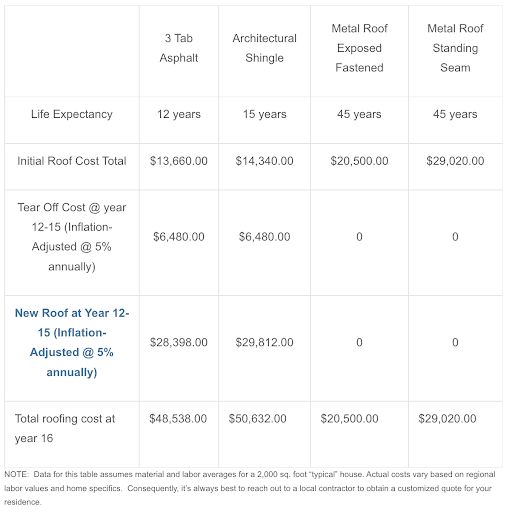
As the table above illustrates, due to the 12–15-year life expectancy for the shingle roofs, it’s necessary to include costs to remove the original shingles and replace them with new shingles in both shingle examples.
Since these expenses are 15 years down the road, it’s also important to note the inflation impact. To arrive at the inflation-adjusted numbers, we used this website calculator with the start year of 2022 and a final year of 2037. Lastly, since metal roofing routinely lasts 50-60 years, no roof replacement is necessary during that same time.
Clearly, with a savings of $20,000-30,000, metal roofing becomes the more intelligent buy if you plan to stay in your home for 10-15 years. But what if you planned to stay in the same house for 30 years?
At that point, you’d need to add another cycle of shingle tear-off and replacement while the original metal roofing is still going strong. See the last three rows added to the table below. And look at the bottom-line totals!
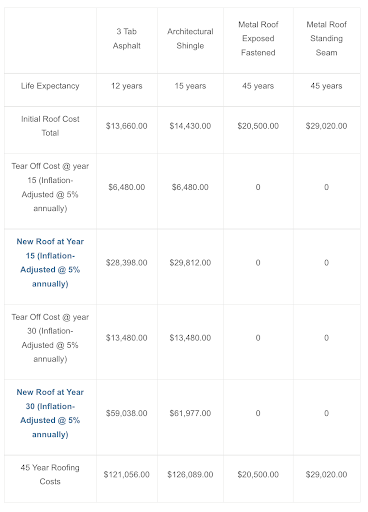
The scenario above doesn’t apply to all homeowners, but the story is incredibly compelling for those planning to put down roots and stay in the same home for 30+ years. For owners in that situation, metal roofing actually “saves” them $90,000-$100,000. That’s a significant amount of money for most homeowners.
Consequently, when you look at cost through the lens of the life cycle instead of first costs, metal roofing paints a clear picture. Much like the printer option we discussed earlier, the higher first cost metal roof products become the lower-priced options once the shorter life expectancy, tear off, and replacement costs for shingle roofs are included in the life cycle cost equation.
Resale Value: It’s important to realize that moving to a metal roof may be a more difficult decision if you plan to sell your home in just a few years. All the same information from the table above still applies; it’s just that you won’t be there long enough to reap the benefits of your investment fully. Since savvy buyers typically consider the roofing condition before making an offer, you may be able to sell your home for a higher price to offset the additional investment of metal roofing. However, to an uneducated buyer, the house may not be worth any more than if it had a shingle roof with 5-7 years of life expectancy remaining.
Consequently, Remodeling magazine indicates you can expect to recoup 61.2% of the cost to install metal roofing and 65.9% for shingles. As consumer education increases, metal roofing continues to gain market share each year, while shingle roofing continues to lose market share each year. Consequently, as consumer awareness and buying habits shift away from shingles and towards metal, homeowners reasonably expect a metal roof to increase the value of their home.
Reduced Maintenance: Metal roofing requires much less maintenance than shingle roofs. Historically most homeowners simply accepted that after storms, hail, and high winds, they should expect a roof replacement or, at the very least, some moderate repairs.
Conversely, metal roofing systems are inherently less prone to damage from Mother Nature because they are engineered to withstand high winds. Metal’s superior performance in high wind is why metal roofing is prevalent in coastal locations.
Energy Savings: For those homeowners concerned with the environment and global warming, it’s important to note that homeowners also save money on their utility bills when they choose metal over shingles. The most significant difference is that shingles absorb heat from the sun and bring the extra heat inside the attic space (and ultimately into the home). Metal roofing reflects most of the sun’s rays into the atmosphere.
According to the United States Energy Administration, the average residential electric bill is $115 per month or $1,380 per year; yours may be higher or lower. Regardless, due to the difference in reflectivity, the Metal Roofing Alliance puts potential savings for homeowners with metal roofing as high as 40%. As the table below highlights, using a conservative number of 20%, energy savings are almost $5,000 at year 15 and over $12,000 at year 30. Again, that is a significant amount for most homeowners.
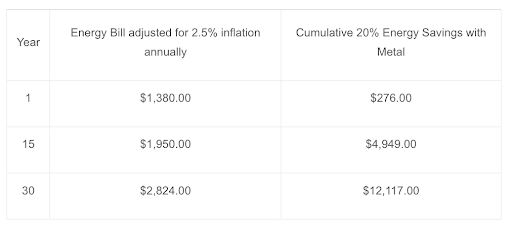
Bottom line: Admittedly, when comparing bids between shingles and metal roofing, the metal roofing will be more expensive from a first cost standpoint. Yet once lower life cycle costs, reduced maintenance, and energy savings are factored in, metal roofing truly has a great story.
Product Type: The broad type of product selected and the family of products within that category significantly impact the cost of any roofing project. So while the first tier decision might be metal or shingles, the second tier decisions include the thickness of the product and style/type of product.
For example, there are two predominant types of metal roofing: concealed fastener and exposed fastener panels. The product and installation costs vary significantly between the two styles. So, while exposed fastener panels on straight gable roofs with low eave heights (like ranches) might be priced comparative to asphalt shingles, a concealed fastener system on a two-story house with a complex roof plan might be much more costly.
Aesthetics: Another critical factor in pricing considerations is aesthetics. Metal roofs come in a wide range of finishes and styles. You can even choose a metal roof that looks like slate, shakes, or tile, and those styles can be a great way to enhance a home immediately through increased beauty as well as the “high end” value implication of an upscale home.
The coating, or paint system, that is factory applied to the metal roof panels also directly affects long-term performance and aesthetics. PVDF (Kynar 500®) paint systems provide the best long-term performance concerning panel fade and chalk. So, if you’re interested in your home's curb appeal, fade and chalk resistance should be high on your list, and you’ll want Kynar 500®/(PDVF) paint.
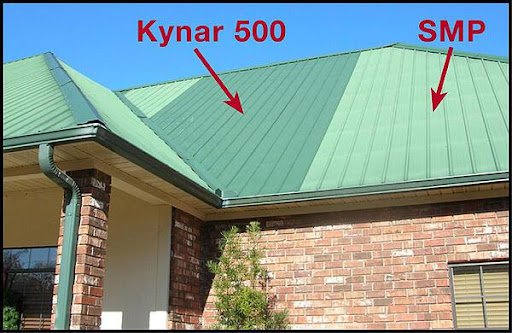
Believe it or not, many suppliers still offer lower-grade paint systems like Silicone Modified Polyester (SMP) for residential applications. Once they understand the differences, most homeowners are more than willing to pay a couple of hundred dollars more on the total cost of their roof to gain the long-term benefits of Kynar 500® coatings.
Installation Costs: Installation costs can be another significant factor in comparing shingles and metal roofing prices. That’s because there’s a big difference in the required skill set between the products. Shingles are well known for being easy to install. With ease comes a cheaper labor rate. On the other hand, metal requires much more skill, finesse, and training. So, it’s only logical that per hour labor rates are typically higher for a qualified metal roof installer than a shingle contractor.
Further, labor rates tend to be higher in metropolitan areas than in remote areas. And the number of contractors installing metal roofs in the area can also make a pretty big difference. For example, suppose you’re in a market with only one qualified installer. In that case, your installation costs will likely be higher than someone with the same house might pay in a highly competitive market with multiple installers performing the work.
For shingles, the advantages are price and low installation costs. While those are certainly valid considerations, both of those attributes are short-term. Conversely, metal roofing is well known for providing long-term value, exceptional performance, and a solid return on investment.
It all boils down to what you want. If low-cost today is your only criteria (and not how long the roof will last), then a shingle roof will be your best option. If, however, you’re more interested in a roof that does the following, then metal roofing could be a serious consideration in your roof replacement journey:
When you reach out to contractors, it’s crucial to have a list of questions ready. And if curb appeal is essential to you, be sure to find out what type of paint systems they use. It’s also important to determine how much metal roofing they have installed. Contractors who only “dabble” or occasionally install metal roofing often steer homeowners toward shingles because it’s their comfort zone. Don’t let someone else’s comfort zone push you to accept a shorter-term solution for what may be the most significant investment you have, your home.
NOTE: This content was published in April 2022 to reflect current material prices and inflation. In these uncertain times, metal roofing continues to be an excellent long-term investment.
When faced with roof replacement, many homeowners have settled for the cheapest, most popular product - asphalt shingles. But over the past several years, a funny thing has happened. Homeowners, tired of the constant churn of shingle replacement, are searching for better roofing options.
Perhaps that’s why residential metal roofing continues to gain in popularity. With increasing frequency, homeowners consider the possibilities of a metal roof on possibly their most significant investment, their home. Based on recent data, metal roofing now holds 12% of the remodel market share and 8% of the spending for new residential construction. Think about those statistics for a moment. That means 12% of the homes needing a roof replacement no longer replace their shingle roof with another roof. Why?
Because, in many cases, they’re simply tired of the never-ending cycle of budgeting for and paying off a roof on their home. In the wise words of Albert Einstein, they’re just over the insanity of it all.
Consequently, many homeowners are researching the possibility of metal roofing for their homes, and of course, product cost is a necessary component of any research effort. With metal roofing lasting three times as long, most homeowners expect the product to cost more; however, the question is, how much more?
Defining Metal Roof Costs
We need to define two terms to discuss costs: first cost and life cycle cost. As you might expect, the first cost is the product cost on the day of purchase. Conversely, life cycle costs also include factors like the life expectancy and maintenance of a product over its lifetime.For a better understanding, let’s look at the comparison of a home office printer. The first costs for printer option #1 are $59.00, while the first costs for printer option #2 are $99. Based on first costs alone, option #1 seems the logical choice; however, upon reading reviews, it seems the print head (the main component) on the cheaper-priced printer commonly fails within the first year and, of course, after the 90 day warranty expires. With an estimated repair bill of $50, the life cycle costs for printer #1 escalate to $109.
And suddenly, the higher-priced printer option #2 may offer better life cycle costs. Ultimately, life cycle costs are the concept of paying more money for a product on day one but reasonably expecting the product to last longer or provide fewer problems during ownership.
We can now apply the same premise to metal roofing panels with a better understanding of life cycle costs. The table below highlights that life cycle costs are a game-changer in comparing shingle and metal roofing costs.

As the table above illustrates, due to the 12–15-year life expectancy for the shingle roofs, it’s necessary to include costs to remove the original shingles and replace them with new shingles in both shingle examples.
Since these expenses are 15 years down the road, it’s also important to note the inflation impact. To arrive at the inflation-adjusted numbers, we used this website calculator with the start year of 2022 and a final year of 2037. Lastly, since metal roofing routinely lasts 50-60 years, no roof replacement is necessary during that same time.
Clearly, with a savings of $20,000-30,000, metal roofing becomes the more intelligent buy if you plan to stay in your home for 10-15 years. But what if you planned to stay in the same house for 30 years?
At that point, you’d need to add another cycle of shingle tear-off and replacement while the original metal roofing is still going strong. See the last three rows added to the table below. And look at the bottom-line totals!

The scenario above doesn’t apply to all homeowners, but the story is incredibly compelling for those planning to put down roots and stay in the same home for 30+ years. For owners in that situation, metal roofing actually “saves” them $90,000-$100,000. That’s a significant amount of money for most homeowners.
Consequently, when you look at cost through the lens of the life cycle instead of first costs, metal roofing paints a clear picture. Much like the printer option we discussed earlier, the higher first cost metal roof products become the lower-priced options once the shorter life expectancy, tear off, and replacement costs for shingle roofs are included in the life cycle cost equation.
Other Cost Considerations
While metal roofing tells a compelling life cycle cost story, a few other topics bear consideration in any cost analysis between shingles and metal roofing.Resale Value: It’s important to realize that moving to a metal roof may be a more difficult decision if you plan to sell your home in just a few years. All the same information from the table above still applies; it’s just that you won’t be there long enough to reap the benefits of your investment fully. Since savvy buyers typically consider the roofing condition before making an offer, you may be able to sell your home for a higher price to offset the additional investment of metal roofing. However, to an uneducated buyer, the house may not be worth any more than if it had a shingle roof with 5-7 years of life expectancy remaining.
Consequently, Remodeling magazine indicates you can expect to recoup 61.2% of the cost to install metal roofing and 65.9% for shingles. As consumer education increases, metal roofing continues to gain market share each year, while shingle roofing continues to lose market share each year. Consequently, as consumer awareness and buying habits shift away from shingles and towards metal, homeowners reasonably expect a metal roof to increase the value of their home.
Reduced Maintenance: Metal roofing requires much less maintenance than shingle roofs. Historically most homeowners simply accepted that after storms, hail, and high winds, they should expect a roof replacement or, at the very least, some moderate repairs.
Conversely, metal roofing systems are inherently less prone to damage from Mother Nature because they are engineered to withstand high winds. Metal’s superior performance in high wind is why metal roofing is prevalent in coastal locations.
Energy Savings: For those homeowners concerned with the environment and global warming, it’s important to note that homeowners also save money on their utility bills when they choose metal over shingles. The most significant difference is that shingles absorb heat from the sun and bring the extra heat inside the attic space (and ultimately into the home). Metal roofing reflects most of the sun’s rays into the atmosphere.
According to the United States Energy Administration, the average residential electric bill is $115 per month or $1,380 per year; yours may be higher or lower. Regardless, due to the difference in reflectivity, the Metal Roofing Alliance puts potential savings for homeowners with metal roofing as high as 40%. As the table below highlights, using a conservative number of 20%, energy savings are almost $5,000 at year 15 and over $12,000 at year 30. Again, that is a significant amount for most homeowners.

Bottom line: Admittedly, when comparing bids between shingles and metal roofing, the metal roofing will be more expensive from a first cost standpoint. Yet once lower life cycle costs, reduced maintenance, and energy savings are factored in, metal roofing truly has a great story.
What Factors Affect the Cost of a Re-Roof project?
The geographic region, eave height, and complexity of the roof (hips/dormers, valleys, etc.) all impact the cost of roof replacement. But beyond that, product selection, aesthetics, and installation costs are also dominant factors.Product Type: The broad type of product selected and the family of products within that category significantly impact the cost of any roofing project. So while the first tier decision might be metal or shingles, the second tier decisions include the thickness of the product and style/type of product.
For example, there are two predominant types of metal roofing: concealed fastener and exposed fastener panels. The product and installation costs vary significantly between the two styles. So, while exposed fastener panels on straight gable roofs with low eave heights (like ranches) might be priced comparative to asphalt shingles, a concealed fastener system on a two-story house with a complex roof plan might be much more costly.
Aesthetics: Another critical factor in pricing considerations is aesthetics. Metal roofs come in a wide range of finishes and styles. You can even choose a metal roof that looks like slate, shakes, or tile, and those styles can be a great way to enhance a home immediately through increased beauty as well as the “high end” value implication of an upscale home.
The coating, or paint system, that is factory applied to the metal roof panels also directly affects long-term performance and aesthetics. PVDF (Kynar 500®) paint systems provide the best long-term performance concerning panel fade and chalk. So, if you’re interested in your home's curb appeal, fade and chalk resistance should be high on your list, and you’ll want Kynar 500®/(PDVF) paint.

Believe it or not, many suppliers still offer lower-grade paint systems like Silicone Modified Polyester (SMP) for residential applications. Once they understand the differences, most homeowners are more than willing to pay a couple of hundred dollars more on the total cost of their roof to gain the long-term benefits of Kynar 500® coatings.
Installation Costs: Installation costs can be another significant factor in comparing shingles and metal roofing prices. That’s because there’s a big difference in the required skill set between the products. Shingles are well known for being easy to install. With ease comes a cheaper labor rate. On the other hand, metal requires much more skill, finesse, and training. So, it’s only logical that per hour labor rates are typically higher for a qualified metal roof installer than a shingle contractor.
Further, labor rates tend to be higher in metropolitan areas than in remote areas. And the number of contractors installing metal roofs in the area can also make a pretty big difference. For example, suppose you’re in a market with only one qualified installer. In that case, your installation costs will likely be higher than someone with the same house might pay in a highly competitive market with multiple installers performing the work.
Top Benefits of Metal Roofing Compared to Shingles
- Metal roofing is durable and routinely lasts 2-4 times longer than shingles.
- Homeowners like the idea of buying only one more roof in their life instead of potentially several.
- Metal roofing outperforms shingles in cases of hail and other severe weather events.
- Metal roofing is highly reflective and can save 20-40% on electricity bills.
- Metal roofing has a high recycled content, which helps reduce landfill pressure instead of adding to it like asphalt shingles.
- Metal roofing looks great, improving curb appeal and resale values.
What Do You Want from Your Roof?
In summary, both metal roofing and asphalt shingles are popular and have their advantages.For shingles, the advantages are price and low installation costs. While those are certainly valid considerations, both of those attributes are short-term. Conversely, metal roofing is well known for providing long-term value, exceptional performance, and a solid return on investment.
It all boils down to what you want. If low-cost today is your only criteria (and not how long the roof will last), then a shingle roof will be your best option. If, however, you’re more interested in a roof that does the following, then metal roofing could be a serious consideration in your roof replacement journey:
- Lasts for decades
- Increases the curb appeal of your home
- Requires less maintenance
- Reduces your utility bills
- Increases the value of your home
Next Steps
If you’re ready to explore metal roofing more and learn what it might cost for your home, the best approach is to contact qualified local contractors and request estimates from those that meet your requirements.When you reach out to contractors, it’s crucial to have a list of questions ready. And if curb appeal is essential to you, be sure to find out what type of paint systems they use. It’s also important to determine how much metal roofing they have installed. Contractors who only “dabble” or occasionally install metal roofing often steer homeowners toward shingles because it’s their comfort zone. Don’t let someone else’s comfort zone push you to accept a shorter-term solution for what may be the most significant investment you have, your home.